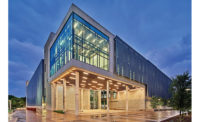2024 Southwest Best Projects
Best Higher Ed/Research — Advanced Engineering Building at University of Nevada, Las Vegas

Photo by 501 Studios Photography
Advanced Engineering Building at University of Nevada, Las Vegas
Las Vegas
BEST PROJECT
Submitted by: CORE Construction
Owner: State Public Works Division
Architect of Record: PGAL
Lead Design Firm: SmithGroup
General Contractor: CORE Construction
Civil Engineer: Poggemeyer Group Inc.
Structural Engineer: Walter P Moore
MEP Engineer: MSA Consulting Engineers
To support increasing interest in STEM fields and engineering, which are among the fastest-growing fields of study at the University of Nevada-Las Vegas, this $55-million, three-story facility will support research in fields such as robotics, cybersecurity, biomedical engineering, energy and water and artificial intelligence.
Spanning 52,313 sq ft, the Advanced Engineering Building (AEB) features an outdoor aviary enclosure for drone testing, maker-spaces, open-concept wet and dry laboratories, a courtyard and other collaborative spaces.
A “flexatorium” is a first-of-its-kind on campus and allows UNLV to support signature activities and larger class sizes. The space serves as a lecture hall by day and events space by night, equipped with auditorium-style seating that can fold up depending on event needs.

Photo by 501 Studios Photography
Completed in October 2023, the AEB sits on a concrete foundation with a structural steel frame and features both a composite and metal panel exterior and single-ply roof. Metal, wood and glass finishes and accents adorn the interior along with polished concrete floors. The exterior facade’s large curtain wall glazing brings natural light into the facility, while exterior metal panel cladding and aluminum industrial sun-shade louvers offer the building a futuristic look. Solar panels and water conservation technologies also improve the facility’s environmental footprint.
Before foundation work could begin, the project team first had to unravel, reroute and reconnect vital underground communication lines. The team also encountered areas where the water table and caliche were not as deep as depicted on the geotechnical and environmental reports.
The hydronic lines that serve the AEB’s HVAC systems came from a central plant located more than a quarter mile away, requiring crews to excavate and install underground hydronic lines through active parking lots and pedestrian walkways within the campus mall.
Before the AEB was built, this site was an open space with grass, benches and several 50-year-old Mondell pine trees. Sections of these mature trees were salvaged and repurposed into student benches for several of the collaboration spaces.




